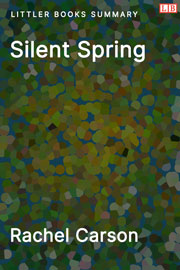Book Description
An environmental science book that documents the harmful effects of indiscriminate pesticide use, and criticizes the chemical industry for spreading misinformation and public officials for uncritically accepting these claims.
If You Just Remember One Thing
Coming soon.
Bullet Point Summary and Quotes
- For most of Earth's history, life has been shaped by its environment, but very recently, humans have gained the capability to significantly alter that environment.
- “It is not my contention that chemical insecticides must never be used. I do contend that we have put poisonous and biologically potent chemicals indiscriminately into the hands of persons largely or wholly ignorant of their potentials for harm. We have subjected enormous numbers of people to contact with these poisons, without their consent and often without their knowledge.”
- Each year, approximately 500 new chemicals are synthesized in the United States alone.
- “Future historians may well be amazed by our distorted sense of proportion. How could intelligent beings seek to control a few unwanted species by a method that contaminated the entire environment and brought the threat of disease and death even to their own kind?”
- Early organic pesticides like arsenic, widely used in weed and insect killers until the 1960s, were found to have toxic and carcinogenic effects, causing sickness or death in a wide range of animals from bees to horses.
- In the years following World War II, the development and use of synthetic poisons to kill pests increased
dramatically, with over 200 chemicals developed between the mid-1940s and 1960s, resulting in pesticide production
skyrocketing to five times its previous rate.
- Many of these chemicals were byproducts of wartime research in chemical warfare.
- The synthetic chemical DDT (dichloro-diphenyl-trichloro-ethane) started to become a widely used pesticide ingredient. It slowly causes deadly damage after entering a target's body.
- “If we are going to live so intimately with these chemicals eating and drinking them, taking them into the very marrow of our bones -- we had better know something about their nature and their power.”
- Synthetic pesticides like DDT led to unintended and deadly consequences on nature.
- They proved far more dangerous than earlier organic pesticides, particularly when they entered water systems, escaping detection in purification plants and contaminating drinking water to lethal levels.
- Case studies across the United States have shown the extensive damage these chemicals cause in animals. For example, at Michigan State University in 1954, local robins were found dead, dying, or unable to reproduce after eating earthworms that had fed on DDT-sprayed leaves.
- Herbicide sprayings in Bridger National Forest, aimed at eliminating sage, unintentionally killed willow thickets along the streams, home to moose and beavers whose dams had created a thriving lake. The loss of the beaver dams depleted the lake and destroyed the landscape.
- In its oil-based spray or gas forms, DDT is dangerously toxic. It can cause serious damage to heart muscles
and liver cells in animals, even in minute amounts (three to five parts per million).
- 648 parts per million were detected in insecticide plant workers.
- Even those without direct exposure to DTT averaged 5.3 to 7.4 parts per million. This is due to DDT's presence in the food chain (e.g., sprayed alfalfa fields -> chicken -> contaminated eggs).
- Pesticides kill indiscriminately, not only targeting pests but also exterminating their natural predators,
thereby disrupting nature's system of checks and balances.
- In 1956, when the U.S. Forest Service sprayed 885,000 acres of woodlands with DDT to combat spruce budworms, it inadvertently killed the natural predators of spider mites. Consequently, spider mites became a worldwide pest, severely damaging forests.
- Dangerous pesticides entered production and use due to a lack of proper testing tools and government regulation, allowing chemically polluted water to go undetected and food contamination to be overlooked.
- “We are accustomed to look for the gross and immediate effects and to ignore all else. Unless this appears promptly and in such obvious form that it cannot be ignored, we deny the existence of hazard. Even research men suffer from the handicap of inadequate methods of detecting the beginnings of injury. The lack of sufficiently delicate methods to detect injury before symptoms appear is one of the great unsolved problems in medicine.”
- We have the right to know about the chemicals used in our environment and food, and understand their risks.
- We must do more to research and implement healthier alternative biological pest control methods such as mass
sterilization of pests and using parasites, predators, pathogens, and pheromones. These not only avoid the
pitfalls of chemicals but are also safer for humans and the environment.
- Dr. Edward Knipling's 'male sterilization' technique, which involves releasing sterilized males to outcompete wild males until only infertile eggs are produced, was successfully tested on the island of Curacao, where it eliminated the native screw-worm population. The program's success led to its replication on a much larger scale in the Southeast, yielding similarly successful results.
- “As crude a weapon as the cave man's club, the chemical barrage has been hurled against the fabric of life -- a fabric on the one hand delicate and destructible, on the other miraculously tough and resilient, and capable of striking back in unexpected ways. These extraordinary capacities of life have been ignored by the practitioners of chemical control who have brought to their task no 'high-minded orientation,' no humility before the vast forces with which they tamper.”
- Nature does not exist for human convenience and cannot be controlled by us. We must not turn our “modern and terrible weapons” against the very earth that sustains us.
Silent Spring: Resources
- Download this summary and 170+ other top nonfiction book summaries in one book (PDF, eBook, DOCX)
- Buy the book
